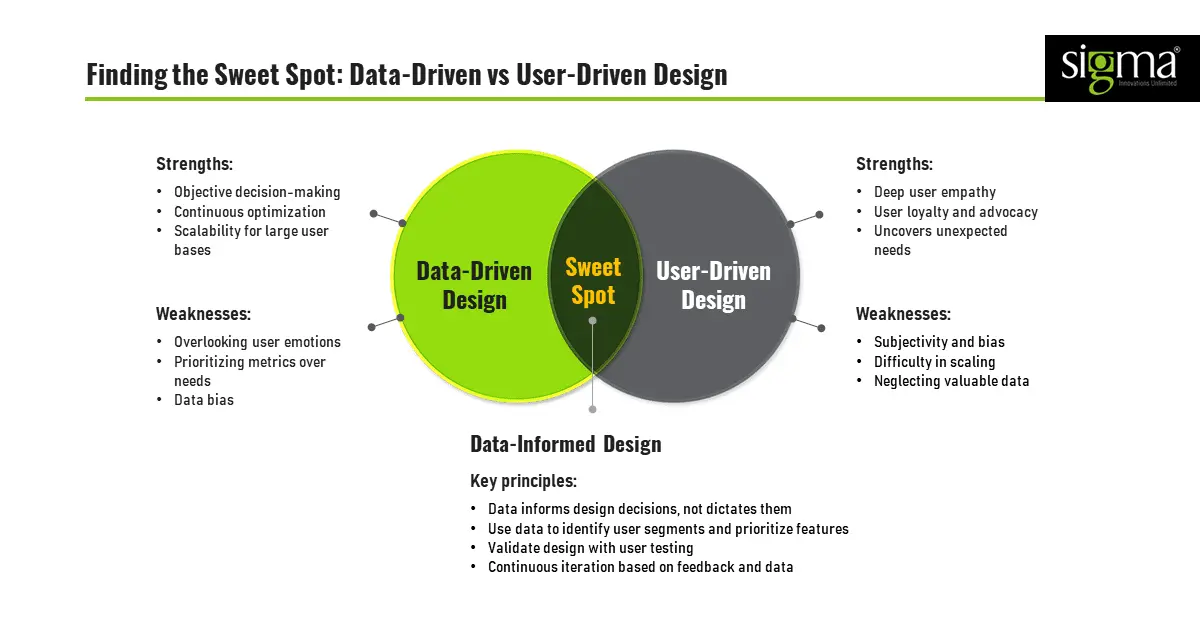Software Product Design: Data Driven vs User Driven

In the ever-evolving landscape of software development, one question reigns supreme: how do we craft products that users adore? Two seemingly opposing approaches dominate the design battlefield: data-driven design, armed with cold, hard metrics, and user-driven design, wielding empathy and intuition as its weapons. But what if the answer lies not in picking a side, but in finding the golden middle ground? Let’s delve into the world of data-driven and user-driven design, explore their strengths and weaknesses, and discover the sweet spot where user-centricity and objective data analysis converge.
Data-Driven Design: Numbers Whispering Insights
Imagine a world where design decisions are not swayed by gut feelings or fleeting trends but by the unwavering voice of data. Data-driven design champions this very notion, its foundation built on the pillars of user behavior tracking, analytics, and the ever-popular A/B testing. It’s a world where every click, scroll, and purchase whispers valuable insights, guiding designers towards features that resonate and functionalities that convert.
The advantages of this approach are undeniable. Data provides an objective lens, eliminating the subjectivity that can cloud human judgment. It allows for continuous optimization, as designers can constantly analyze user behavior and iterate based on concrete evidence. Additionally, data scales beautifully. With the right tools and infrastructure, designers can cater to vast user bases, tailoring experiences to diverse needs, all informed by the symphony of user data.
However, data can be a seductive siren, luring designers towards the rocks of user neglect. The danger lies in mistaking metrics for emotions, and prioritizing clicks over user satisfaction. Data reveals what users do, not why they do it. The warmth of human emotions, and the frustrations that simmer beneath the surface, these crucial aspects can be easily overlooked in the cold embrace of numbers.
Furthermore, data can be a double-edged sword. Biased data collection or flawed interpretations can lead to solutions that cater to a specific segment, ignoring the needs of the broader user base. Remember, the data you collect is only as good as the questions you ask.
User-Driven Design: Walking in Users’ Shoes
Now, let’s shift gears and step into the world of user-driven design. Here, the compass points towards empathy, the map drawn by user needs, desires, and pain points. User research, interviews, and usability testing become the sacred rituals, unveiling the unspoken desires and hidden frustrations that lie dormant within the user’s mind.
This approach fosters a deep connection with the user, resulting in products that feel intuitive, even magical. Users don’t just use the product; they connect with it, becoming loyal advocates who champion its cause. The user-driven design also unlocks the doors of innovation. By truly understanding users, designers can uncover unexpected needs and craft solutions that push the boundaries of what’s possible.
Yet, even the most empathetic designer can encounter roadblocks. Subjectivity can creep in, coloring research findings with personal biases. Scaling user-centered approaches for large user bases can be a logistical nightmare, and the allure of data’s objectivity can be hard to resist.
Ignoring the wealth of insights hidden within data would be a grave mistake. User-driven design flourishes when paired with data-driven validation. User feedback can guide the initial direction, while data helps refine and prioritize features, ensuring they resonate with the larger user base.
Data-Informed Design: The Harmonious Marriage
So, is there a way to escape this binary trap? Can we transcend the limitations of both approaches and create a design philosophy that embraces both data and user empathy? The answer lies in data-informed design, the sweet spot where objective metrics waltz hand-in-hand with user-centricity.
Data-informed design doesn’t dictate; it informs. It uses data to identify key user segments and prioritize features that cater to their specific needs. It validates design assumptions and prototypes through rigorous user testing, ensuring the product resonates with its intended audience. It encourages continuous iteration based on a feedback loop of user insights and data analysis.
This approach demands a balanced mindset, one that respects both quantitative and qualitative data. It requires designers to wear two hats: the data analyst, meticulously interpreting numbers, and the empath, listening intently to the whispers of user needs.
Imagine a world where design decisions are not battles between data and intuition, but graceful dances between objective analysis and user understanding. This is the promise of data-informed design, where products are not only data-optimized but also deeply loved by users.
Learning from Real-World Footprints: Case Studies
Let’s solidify these concepts by examining two contrasting case studies: Spotify, the data-driven titan, and Slack, the user-centric champion.
Spotify: The Data-Driven Maestro
Spotify’s rise to music streaming dominance is a testament to the power of data-driven design. They meticulously track user behavior, from skipped tracks to genre preferences, feeding this information into their recommendation engine. This data-fueled personalization keeps users engaged, discovering new music they never knew they craved.
Their A/B testing prowess is legendary. From tweaking button placements to experimenting with different shades of green, they constantly optimize the user experience based on real-time data. This relentless focus on metrics has undoubtedly contributed to Spotify’s massive user base and impressive retention rates.
However, Spotify’s reliance on data isn’t without its critics. Some argue that the focus on algorithms can homogenize the listening experience, limiting users’ exposure to diverse and challenging music. Additionally, the black-box nature of their recommendation engine can leave users feeling like cogs in a data-driven machine, lacking agency over their own musical journey.
Slack: The User-Centric Champion
Slack, the communication platform for the modern workforce, took a different route. They prioritized user research and feedback above all else, conducting countless interviews and usability tests to understand the pain points of remote teams. This deep empathy resulted in features like threaded conversations, real-time searches, and emoji reactions, all meticulously crafted to address specific user needs.
This user-centric approach fostered a passionate community around Slack. Users felt heard, and their needs were reflected in the product’s evolution. This emotional connection fueled virality, turning Slack into the go-to tool for teams of all sizes.
However, Slack’s focus on user feedback also presented challenges. Scaling features based on the needs of a diverse user base could be tricky. Additionally, prioritizing user requests over data-driven insights could sometimes lead to features that didn’t resonate with the broader audience.
The Harmony of Data and Empathy: Lessons Learned
These contrasting case studies illustrate the strengths and weaknesses of both data-driven and user-driven design. Spotify’s data prowess fueled personalization and engagement but risked homogenizing the user experience. Slack’s user-centricity fostered a passionate community, but scaling features based on diverse needs could be difficult.
The key takeaway? Data and empathy are not rivals; they are powerful allies. By embracing data-informed design, we can leverage the objectivity of numbers to validate user assumptions and prioritize features. We can use data to identify user segments and tailor experiences to their specific needs. But we must never lose sight of the human element. Data tells us what users do, but user research tells us why they do it.
By combining the rigor of data analysis with the warmth of user understanding, we can design products that are not only data-optimized but also deeply loved by users. The human element should always remain at the forefront of our thinking. Products that become an essential part of the user’s journey, not just another tool in their digital toolbox.
Conclusion
At Sigma Infosolutions, we believe in this vision wholeheartedly. We’re not just data analysts or user researchers; we’re design storytellers, weaving together the threads of user needs and data insights into tapestries of exceptional experiences.
We leverage cutting-edge data analysis tools to understand your users like never before. We conduct in-depth user research to uncover their hidden desires and frustrations. And we bring them both to the table, creating software products that resonate with every click, scroll, and sigh of satisfaction.
So, don’t let the data-driven vs user-driven debate hold you back. Let Sigma Infosolutions be your guide on the path to data-informed design. We’ll help you build software products that users don’t just use, they adore. Products that become their companions, their confidantes, their partners in progress.
Are you ready to design with both hearts and minds? Let’s start a conversation and watch your vision come to life.
